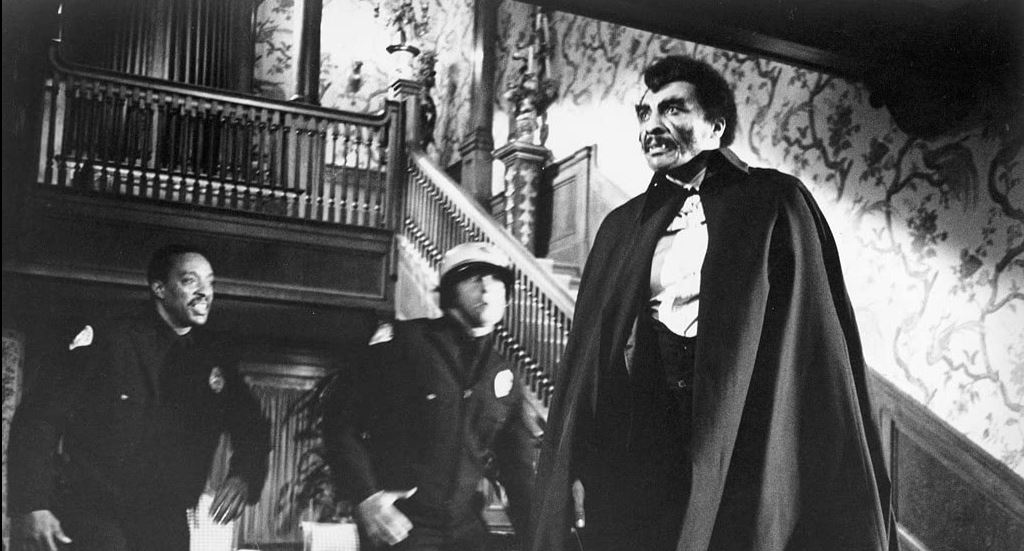
Blaxploitation
As you probably know, I likes me a bit of blaxploitation, even though much of it was an unashamed rip-off of whatever whitey was up to. Westerns, horror, crime, comedies… the blacks always had some sort of crappy facsimile to hand as typified by the likes of Blacula and Black Shampoo. Well, everyone’s gotta start somewhere, a perfectly acceptable excuse for enabling decent actors, directors and writers to get a foothold in a hitherto not exactly welcoming industry. Occasionally while watching a prime slice of blaxploitation you can almost hear some of the cast thinking Ain’t this great? We’re finally doing our own thang…
Now I’m still building my knowledge of this exploitation sub-genre, but my initial rooting around into its first wave hasn’t been a roaring success. Sometimes it’s near-impossible to get past the fashion e.g., just take a gander at the titular pimp’s array of brazen outfits in Willie Dynamite. At other times an excess of dancing, anti-drug finger-wagging and deeply dodgy acting prove fatal (1979’s amazingly incompetent Disco Godfather). Having said that, I often enjoy blaxploitation’s jive talk, funky music, racial tensions, depictions of ghetto life and yes, the stereotypes. Plus, there’s really nothing wrong with the uncompromising grit of Across 110th Street, the entertaining lunacy of Three the Hard Way and the sheer unrelenting horror of Mandingo.
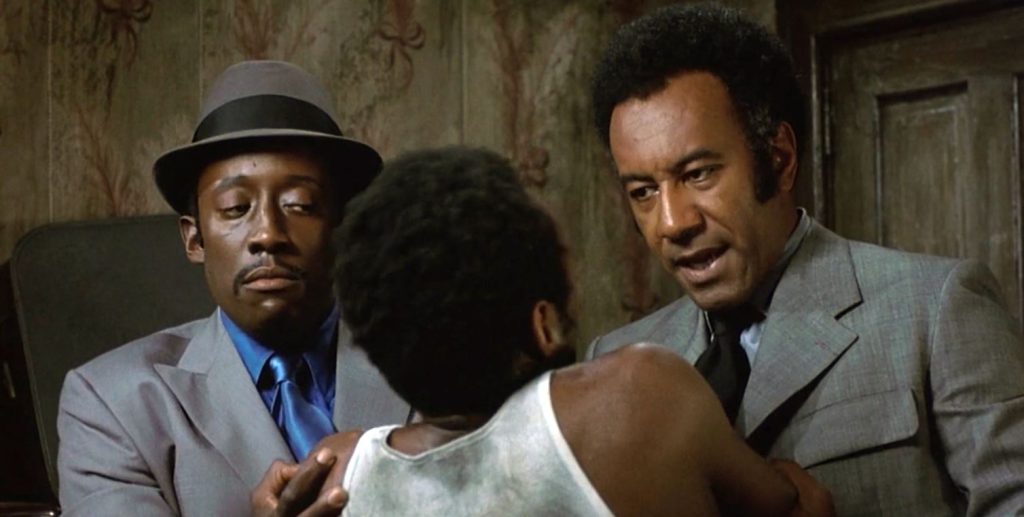
But where did blaxploitation start? Apparently, 1970’s buddy cop flick Cotton Comes to Harlem is a good bet. It’s a weird, not entirely successful blend of comedy and action that never finds a consistent tone, although it did well enough to produce a sequel two years later. Its strengths include a shit load of outdoor filming (that provide a vivid portrait of the borough), decent acting, a lively approach and a naked chick telling a bamboozled police officer: “They say the badder the woman, the better the smell. Come sniff.” Bloody hell, why don’t women ever say things like that to me?
Charismatic preacher and poncy showoff Deke O’Malley (Calvin Lockhart) has been busy raising money to buy a ship that will help Harlem’s blacks relocate to Africa. At a well-attended outdoor rally he tells his cheering people: “Goodbye rats and roaches… Goodbye having to live on white man’s welfare. We are going home!”
Now my knowledge of black history might be lacking here, but did blacks really want to piss off to Africa in the late 20th century? I know Harlem had significant problems, such as crime, poverty, racism and drugs, but surely it was a helluva lot better than Nigeria or the Congo? And anyway, how would the whole residency/citizenship thing work? You can’t just rock up to a new country on the basis you don’t like the old one.
Then again, I guess that’s a side issue. Back to the movie. At the rally a bunch of masked armed men steal the eighty-seven grand Deke has raised. Bummer. Two black cops, the unlikely-named Coffin Ed and Gravedigger (Raymond St. Jacques and Godfrey Cambridge), are handed the task of finding out what went down. It’s a question of whether Deke’s in on the rip-off, but considering he’s already happily revealed he’s an ex-convict and that God told him in a dream to build an ark, I’ll let you figure it out.
Cotton is not a dull watch as it chucks in whatever it can find, such as the subgenre’s staples of racial distrust, police brutality and religion. It lacks coherence, but it does have a decent car chase, a funny watermelon-eating gag, a hot black chick running around naked and a not so hot honky male cop running around naked. Sometimes the comedy is grounded, sometimes it’s pure farce, but people getting shot to death, phrases like ‘nigger pig cop’ and women being belted don’t sit brilliantly with its overall knockabout manner. Still, any movie featuring Rock Ridge’s future mayor can’t be all bad.
A year after Cotton came out a cocksure private dick by the name of John Shaft was filmed strutting around a different part of Harlem in his black leathers, accompanied by an Oscar-winning theme tune. Blaxploitation was about to explode.
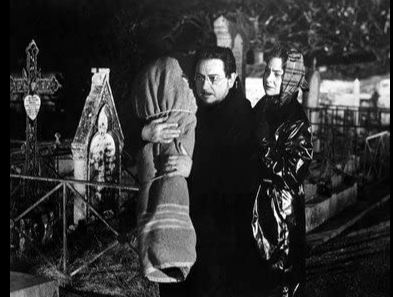
The Mad Doctor/Scientist
Who doesn’t love a bloke with a fevered ego in a white coat self-experimenting or flat-out killing folk in a bid to advance the frontiers of medical knowledge? Such a demented archetype has given us a plethora of fantastic flicks that include Re-Animator, Eyes Without a Face, Island of Lost Souls, and The Fly.
The most famous, Frankenstein, came along in 1931, but there was also another mad doctor plying his trade the same year. His name was Dr. Jekyll (the Oscar-winning Fredric March). This guy’s as ambitious as they come, faintly contemptuous of conformist, lily-livered colleagues and most definitely sexually frustrated. Not that he advertises his flaws. Indeed, to the outside world he’s a saint, helping crippled children walk and operating in his own time on charitable cases. He loves his fiancee and even has a sense of humor.
But he’s a restless man, not wanting to wait for anything, whether it’s knowledge or his girl’s virginity. He wants the future now. Listen to him giving a lecture to his esteemed associates: “Gentleman, London is so full of fog that it has penetrated our minds and set boundaries for our vision. As men of science, we should be curious and bold enough to peer beyond it into the many wonders it conceals.”
Uh-oh. I think it’s gonna be a case of curiosity killing the cat. Jekyll’s impatience grows worse when he intervenes in a street brawl and ends up carrying a working class girl to her bedroom. Suddenly he’s in a different world where the locals speak funny and are a lot earthier. Not to mention the rescued girl saucily tossing garters at him and placing his hand on her bare thigh… No wonder the reluctantly departing Jekyll remarks: “It’s the things I can’t do that always tempt me.”
The subject matter of Dr. Jekyll and Mr. Hyde remains timeless in the way it taps into our perennial frustrations at having to be nice guys and play the game as expected. Keeping up appearances and so on. Surely most of us want to occasionally yell Fuck it! and knock back that frothing, psyche-dividing potion? I mean, look at what it does to Jekyll. One moment he’s kowtowing to his prospective father-in-law about marriage plans, the next he’s shaking a fist and staring at the simian Hyde in the mirror: “Free! Free at last! You hypocrites, you deniers of life, if you could see me now, what would you think?”
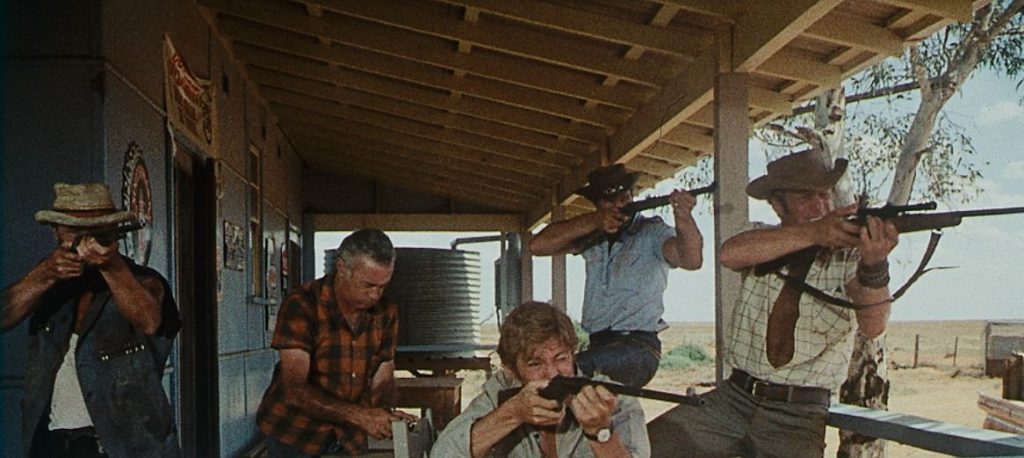
Toxic Masculinity
I have a theory that we’re not too far off seeing the day when men start growing breasts. Indeed, I feel the western world’s commitment to lefty feminization makes this tragic prospect inevitable. Men are bad, you see. We’re sexual predators. Thugs. Sexist wankers. I dunno, we eat too much red meat or something, and need to be a bit more civilized and considerate. Tone our behavior down. Then we might understand that everyone and everything must be respected. It’s amazing, really, that some of us still haven’t grasped that banter is wrong, even when happily reciprocated. For Christ’s sake, put an end to those piss-taking songs at the footy. Curb your drinking. Stop with the macho antics. End the insensitive pranks. Shave off the chest hair, you bloody caveman. Go and change that diaper. Don’t you know saying stuff with a tongue in cheek or a twinkle in the eye is no longer a defense against being labeled something nasty that ends in phobe or ist?
Well, enough is enough.
It’s time men started behaving like men again. It’s time we reclaimed our manliness. Please get in touch if you wish to set up a fight club, a punishing yet liberating arena to reassert our innate, blood-spattered aggression. Of course, I won’t be taking part in any such brutal displays of hyper masculinity as I’ll be too busy working on my B cup, but I am prepared to heartily cheer on the brave participants and hand out halftime refreshments. Are you in?
Anyway, I have no idea when the term ‘toxic masculinity’ gained currency, but it’s clearly become a popular stick to beat men. Movie-wise, it’s got a fair old tradition and is easy to spot in such classics as Once Were Warriors and my fave, Wake in Fright. Back in 1960 we can see its origins in the ace kitchen sink British drama, Saturday Night and Sunday Morning. Based on Alan Sillitoe’s vivid novel, it focuses on a handsome, self-centered working-class lad who slaves away at a lathe all week before bursting butterfly-like into glorious life once the factory whistles blown. Except this butterfly’s a bruiser. Within a few hours he’ll have necked ten pints, smoked forty fags, upset at least a couple of pub-goers with his physical and verbal carelessness, had a fight or two, banged a workmate’s wife, and fallen blind drunk down the stairs.
Not that he’s likely to apologize the next day.
“I’d like to see anyone grind me down,” he boasts. “That’d be the day. What I’m out for is a good time. All the rest is propaganda.”
Arthur Seaton, as played by the fantastic Albert Finney, doesn’t take shit from anyone. This means he’s in a sulky state of near-perpetual conflict. At the mechanized hive he calls work he dislikes ‘brownnosers’ and the foreman, a man who has ‘a fat gut and lots of worry’. Cowed old-timers have wasted their lives. His harried mum and tea-drinking, TV-watching dad are ‘dead from the neck up’. As for women, he’s got an angling analogy: “Never bite unless the bait’s good. I won’t get married till I’m good and ready.”
As you can probably tell, Arthur is one of those mouthy guys who see traps everywhere. He’s brilliant at knowing what he doesn’t want, but not so great at figuring out what he’s after. He might talk big, he might ruffle a few feathers, but reality does tend to intrude on the heroic picture he paints of himself. For this is a man who rides a bicycle to his monotonous job, catches the bus and lives with his parents. To be fair, viable options do seem limited for such a bright, aggressive chap, summarized by a mate who tells him: “All you can do is go on working and hope something good’ll turn up.” In the meantime (before he makes his big move) there’s always Saturday night, a time of hedonistic escape. Or as that disco-dancing god Tony Manero concisely put it seventeen years later: “Fuck the future.”
Saturday Night conjures up a wonderful world of working class life, replete with terraced houses, kids playing on cobbled streets, washing lines strung across alleyways, headscarf-wearing, gossiping housewives, sing-a-longs in smoke-filled pubs, gruff blokes in flat caps, industrial accidents, backstreet abortions, fishing at the canal, and people calling each other ‘duck’. Can our brusque, deceitful, vaguely cruel hero escape living out the rest of his life in such surroundings or is he going to meekly settle down, lose the toxicity and grow a pair of tits?
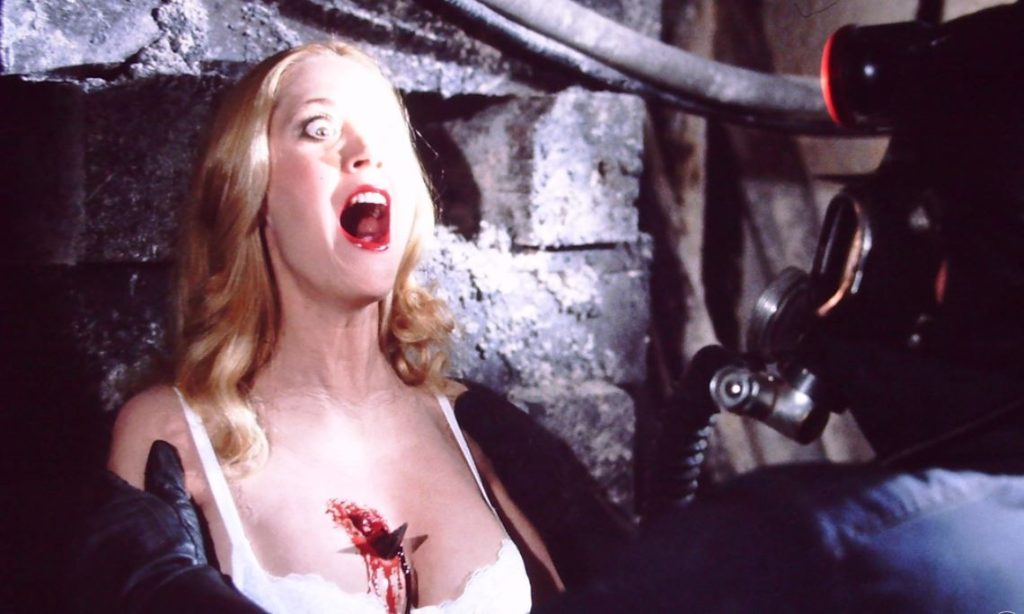
The Slasher
As far as I can tell, people enjoy watching slashers for four reasons: the gory or inventive murders; young women getting their just desserts for stupidly daring to be attractive, naked, half-naked or sexually active; the whacked-out reason for the slayings; and the whodunit aspect. I guess some fans also enjoy the choice of weapon. This might include a hammer, a scythe, a javelin or a kebab skewer (although I feel it’s a pity no killer has tried his luck with razor-sharp sarcasm).
Now although I spent a good deal of my lamentable, glue-affected youth consuming slashers, I don’t care for them. The vast majority, especially from the 80s onward, are pretty damn tedious. Some, however, remain well regarded, if not cult favorites, such as The Prowler, My Bloody Valentine, Just Before Dawn, Happy Birthday to Me and The Burning (which would’ve been immeasurably improved if fledgling producer Harvey Weinstein had been set on fire instead). Still, I have little idea why fans give these movies any more than a cursory viewing. Sure, there’s the odd decent kill, and I am partial to Cropsy rearing up from that canoe and gleefully slicing off those campers’ fingers, but it’s never long before such simplistic, plodding flicks collapse under their own absurdities.
Slashers peaked in the early eighties when it seemed we were getting one every couple of weeks, a production line of homicidal havoc sparked by Halloween’s gigantic success in 1978. Nothing replicated that flick’s commercial high tide, but Friday the 13th two years later did a helluva lot better than most by raking in sixty mil worldwide.
Fuck knows why.
It’s a dull, nonsensical, poorly directed ninety minutes, even if we are treated to the sight of young Kevin Bacon’s buttocks. In fact, Friday demonstrates many of my pet peeves with the sub-genre in that the killer often possesses superhuman strength (despite being a middle-aged mom), as well as one of those interminable back from the grave endings. Or am I just being nitpicky and failing to enter into the spirit of things?
Well, surely you’ll agree that Jason Voorhees is a damned sight less interesting than his sweater-wearing mom. Fucking hell, how many times did that hockey mask-clad numbnuts bumble through one carbon copy of a movie after another? I think I quit after four installments, which was about three too many.
At any rate, around the time of Friday the 13th‘s release, slashers had become increasingly controversial with their explicit gore. Many ran into trouble with the censors, a prime example being 1982’s The New York Ripper. Here we get a masturbating woman watching a live sex show, an oblivious mutt happily retrieving a severed hand, a female nipple being sliced through with a razorblade, a pathologist talking about ‘good, efficient butchery’ and the unbelievable decision to have the police-taunting killer quack like a duck. And not even a level-headed sounding duck, but one that comes across like it’s been inhaling helium.
Ripper is a monotonous trawl through mechanical depictions of sleaze, managing to lack atmosphere, tension and scares. It just lurches from one implausibility to the next before ending with a predictably bonkers attempt at an ‘explanation’. I mean, the whole point of stuff like this is to give you a visceral jab. Supposedly one of the nastiest slashers out there, all it made me do was try to find the discipline to get up and give my lawnmower an oil change instead. Nice location work, though.
So, in summary, I don’t like slashers, but there are exceptions to their blunt, vaguely depressing mediocrity. Now while it’s difficult to define a pure slasher (as so many horror movies like Psycho and Peeping Tom have a hefty dose of slasher elements), I’d argue that the best of the fucked-up bunch are 1974’s Black Christmas and Texas Chainsaw, Halloween and 1984’s Nightmare on Elm Street. Pinning down the origins of such movies is not easy, though, but I’m going to plump for Mario Bava’s 1971 offering, A Bay of Blood.
Not that I’m a fan of Italian horror, either. It’s too ill-disciplined for my taste. The titles are often lyrical and bloody great (The House with Laughing Windows, The Red Queen Kills Seven Times, The Bird with the Crystal Plumage), but the actual movies are little more than a few imaginative kills adrift in a sea of incoherence. I always appreciate plausibility (a very difficult thing to pull off in horror flicks) but the antics of giallo’s black-gloved killers often run expressly against such an old-fashioned notion.
A Bay of Blood (also known as Twitch of the Death Nerve and about five different other titles) is no different. It has an excellent, unexpectedly inventive opening in which a killer gets killed. Unfortunately, herein lies the problem: this might be flashy and attention-grabbing, but it’s also deeply contrived.
However, there’s no doubt Bay is a prototype slasher. And so the members of a small group are picked off by a prowling murderer who only has the vaguest, if any, connection to them. All the typical ingredients are present and correct: a local resident warning of doom (“There will be tears shed over the bay”), an array of fun-seeking, characterless young people to act as knife fodder, snatches of voyeurism, honeys in a state of undress, gruesome, explicit murders, shots from the killer’s POV, the superhuman strength (as shown by a spear being driven through two bodies), red herrings, and a flimsy, if not bloody silly reason for the mass of bodies.
Still, Bay remains a significant horror movie that boasts a fine location, as well as above-average direction, cinematography and music. Some of the splatter work was so good that the Friday the 13th franchise was obviously happy to copy. I wouldn’t knock its opening forty minutes, but I still feel it’s operating on a basic level that can’t match the imaginative and subversive extremes of the best horror. The longer Bay goes on, the more the cracks in its construction appear. By the hour mark, it’s gone insane.
I did like the writhing squid on a corpse’s face, though.
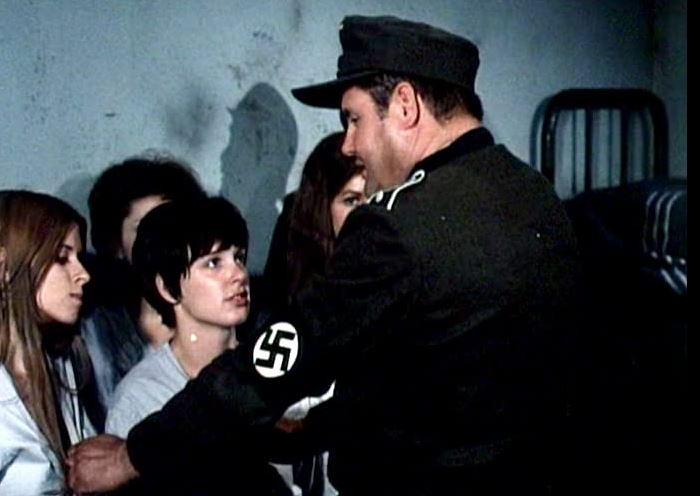
Naziploitation/Women in Prison
When it comes to directing, Lee Frost is a long way from a household name, but the low-budget exploitation stalwart sure gave us his best shot. There wasn’t a grimy subject he wouldn’t roll around in whether it was roughies, head transplants, disfigured bikers, castration or witchcraft. And then, of course, there was 1969’s Love Camp 7, a pic that not only got Naziploitation up on its jackbooted feet but also launched the perennially popular babes-behind-bars sub-genre.
However you look at it, that’s some sort of cinematic achievement.
Shame Love Camp 7 is such a dreary, repetitive, cheapo state of affairs. It centers on a hush-hush plan to send two undercover women into a military brothel to extract sensitive info from a female scientist who somehow knows about advanced jet engine manufacture. “Both are experts in the field of guerilla warfare, hand to hand combat and karate,” their boss confidently says. “In addition, they speak French and German. I feel confident these women can handle the mission.”
Yeah, but do they look good unclothed?
Hmm, I shouldn’t joke. This is an explicit, really quite unpleasant pic that features lengthy bouts of rape, whippings, a lesbian orgy, enforced boot licking, and bashful officers keen to maintain the dignity of their rank by refusing to take their trousers off in the presence of Untermensch. Our chief bad guy is a black-clad commandant, a combat-avoiding coward who does appear rather short and tubby to be a representative of the so-called master race. His personality veers between disdain, sarcasm and screaming fits of rage. Never mind, I’m sure he’s nice to his kids.
“I cannot guarantee that you will love Love Camp 7,” he tells the latest bunch of unfortunate (but shapely) inmates, “but I can guarantee you will love in Love Camp 7. You have been brought here for one purpose, and one purpose only, and that is to please the front line officers of our army… To please will be your only function.”
His best scene involves his subordinate goons holding down a spread-eagled naked prisoner on his desk as a scarred female doctor does the rubber glove thing. “I understand that your father was a banker,” he muses as the inmate writhes and grimaces inches from his face. “I should imagine what with the war and everything that the banking business isn’t what it used to be. Certainly, the interest rates are down, ya?” It’s a nice piece of disassociation that might have served as the inspiration for Bret Easton Ellis’ sociopath prattling about Huey Lewis and the News while carrying out his abominable acts of violence.
But that’s about the only good thing I have to say about Love Camp. I didn’t enjoy it anywhere near as much as the equally nasty, but much more campy, ridiculous and inventive Ilsa, She Wolf of the SS. In that pic at least it was a bunch of Nazi vixens overwhelmingly dishing out the abuse, but in Love Camp it’s the men so it feels ten times uglier and more misogynistic. There’s no energy in the direction, the sets are a joke, the acting ranges from mediocre to poor, there’s never any sense of events taking place in the early years of the war, and you can tell the whole shebang is nothing more than a flimsy excuse to humiliate women.
Saying that, I wouldn’t underestimate how many mutated, retarded and ultimately loveable children Love Camp birthed.